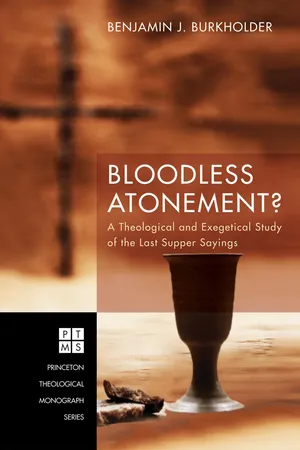
Bloodless Atonement?
A Theological and Exegetical Study of the Last Supper Sayings
- 292 pages
- English
- ePUB (mobile friendly)
- Available on iOS & Android
About this book
Does the Messiah have to die to pay for his people's sins? Is the cross of Jesus an atoning sacrifice? In recent decades a burgeoning number of theologians have answered the aforementioned questions in the negative. In fact some, like Rene Girard, have gone so far as to assert that seeing the cross as an atoning sacrifice undermines the very essence of the New Testament Gospels.While Girard and others following in a similar vein have offered provocative alterations to soteriology that no longer need Jesus's death to acquire forgiveness from God, does a bloodless atonement have biblical support? Does a nonviolent understanding of the atonement harmonize with the Gospels? This particular volume answers these questions with a fresh look at the Synoptic portraits of the Last Supper accounts. In them Jesus expounds upon the significance of his death by using the Passover symbols of bread and wine. More importantly, in these passages in the Gospels we find the fullest articulation of how Jesus's death benefits his followers. Holding a wealth of dense theological riches, these passages provide theological parameters that can inform contemporary soteriological development, especially that which appeals to the New Testament for its basis. Conversant with both biblical studies and contemporary theology, the work seeks to bring the best of both fields into conversation in productive new ways.
Frequently asked questions
- Essential is ideal for learners and professionals who enjoy exploring a wide range of subjects. Access the Essential Library with 800,000+ trusted titles and best-sellers across business, personal growth, and the humanities. Includes unlimited reading time and Standard Read Aloud voice.
- Complete: Perfect for advanced learners and researchers needing full, unrestricted access. Unlock 1.4M+ books across hundreds of subjects, including academic and specialized titles. The Complete Plan also includes advanced features like Premium Read Aloud and Research Assistant.
Please note we cannot support devices running on iOS 13 and Android 7 or earlier. Learn more about using the app.
Information
Girard’s Soteriology and Salvation History
Table of contents
- Title Page
- Acknowledgments
- Abbreviations
- Introduction
- Chapter 1: Girard’s Soteriology and Salvation History
- Chapter 2: Reading the Bible With the Girardians
- Chapter 3: Jesus as Savior in Which Story? (Part 1)
- Chapter 4: Jesus as Savior in Which Story? (Part 2)
- Chapter 5: The Cross of Christ in Mark
- Chapter 6: Matthew and Jesus’ Death for the Forgiveness of Sin
- Chapter 7: The Cross, Covenant, and Forgiveness in Luke
- Chapter 8: Assessing the Biblical and Theological Foundations of Girard’s Soteriology
- Chapter 9: Girard, Renewing the Covenant, and Ways Forward
- Bibliography